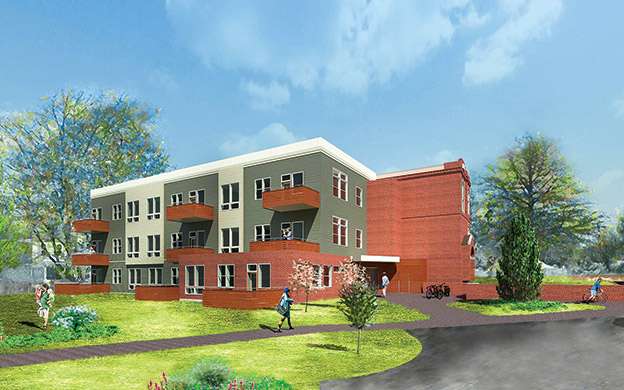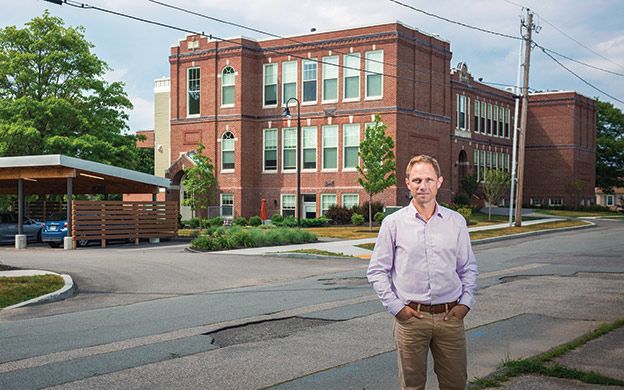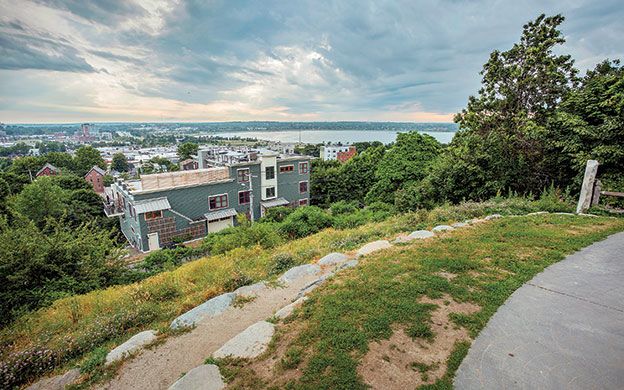
YIMBY, Maine style: 'Smart' growth sought to ease space crunch
Ethan Boxer-Macomber, founder of Anew Development, wanted to convert an old school into housing, while focusing on the advantages of being within walking and biking distance to area services in South Portland.
He used what are known as “smart growth” principles for the development of Meetinghouse Lofts, a project he completed at 341 Pine St.
The project, which won 2016 Historic Preservation Award from Greater Portland Landmarks in the Adaptive Reuse Category, was a redevelopment of the former Roosevelt School, which opened in 1927 but had been vacant since 2012. Boxer-Macomber expanded the original 18,000-square-foot masonry building by two-thirds and created 19 market-rate condo units, ranging from the middle $200,000s to the high $300,000s.

“It's a great example of a project that demonstrates smart growth in action,” says Boxer-Macomber, a member of GrowSmart Maine's board of directors. “Nineteen households are within walking and biking proximity to a comprehensive array of goods and service — the Mill Creek shopping district, recreation, entertainment. At the same time, living within an established neighborhood brings residents closer to each other and to the neighborhood around them.”
High density, human scale
Smart growth principles are gaining cachet in Portland and elsewhere in Maine, as developers and planners alike look to create human-scale communities that incorporate forward-looking social, economic and environmental considerations.
According to Smart Growth America, a Washington, D.C.-based nonprofit, smart growth is a pro-development approach “that encourages a mix of building types and uses, diverse housing and transportation options, development within existing neighborhoods, and community engagement.” Strategies include high-density land use, infill and efficient transportation links.
The trend is a response to millennials, baby boomers and others flocking to cities with, on the other hand, a rejection of decades of suburban sprawl.
In Maine, two nonprofits, GrowSmart Maine in Gardiner and Build Maine in Lewiston, are providing resources, networking opportunities and demonstration projects.
“We're at a great moment for smart growth,” says GrowSmart Maine's community outreach director, Tyler Kidder. “People appreciate the value of a livable community, and the features of a livable community almost always tie back to smart-growth principles.”
Smart-growth principles, she says, “encourage us to grow without destroying what we love about any place. It allows choices in where we live, work and play, and in how we travel.”
She cites transportation choices, housing in a range of prices and investment that supports “quality of place.” Growth is encouraged where development and infrastructure already exist, in order to conserve open space, farmland and forest.
“So it's a system,” Kidder says. “When we think about livable places, we want there to be interesting, vibrant walkable places where people can live and work with access to beautiful, open, natural areas. We find that millennials and elders want the same thing. And if you have children of school age, it would matter to you if they could walk to school. It's village-designed with a community core.”
Smart growth in action
In South Portland, Meetinghouse Lofts converted a vacant property, “turning it from being what was a blight and a liability to the community, into now a meticulously restored property that's contributing to the city's tax base. Repurposing the school in an existing neighborhood made use of the existing public infrastructure — streets, sidewalks, water and sewer lines, trash and plowing routes,” Boxer-Macomber says.
“That's an efficient way to develop, in terms of not further taxing municipal budgets,” he adds.
He argues that Meetinghouse Lofts creates a socially cohesive community that brings together residents previously living in single-family-home neighborhoods.
From the economic standpoint, he says, it now earns tax revenue, helped property values in the neighborhood. Environmentally, he says, energy-efficient systems minimize environmental impact; additionally, the project reduces auto and fuel dependence.
“My 19 buyers valued the idea that they could be less auto-dependent,” he says. “Many went from being a two-car household to one. Many enjoy that they can ride their bikes.”
Becoming mainstream
Kevin Bunker, a founding principal of the Portland-based Developers Collaborative, recalls he first learned about smart growth as an urban planner in the early 2000s.
“It was not mainstream then,” he says. “But in the years since, it's become mainstream. The average citizen, whether or not they call it smart growth or not, thinks that walkability and a sense of community are good things. In the last week, I've been in Milwaukee, Minneapolis and New York City. You see apartment buildings going up downtown and people flocking to live downtown. In the 1960s, '70s, '80s, people were fleeing the downtowns. So the national consciousness has come around and understands that this is the way people want live.”
GrowSmart Maine's Kidder agrees: “What's starting to come up, especially in some of the more urban areas, is the idea of walkable downtowns, outdoor events, small business redevelopment, historic building restoration — those are essentially smart growth principles, whether people call it smart growth or not. So we're seeing a renaissance of smart growth in Maine.”
The movement is ripe for millennials, she says. “They're getting fewer cars than their parents did, so we know that people appreciate the value of a livable community. And the features of a livable community almost always tie back to smart growth principles.”
Still, notes Bunker, the trend is more muted in Maine.
“Smart growth comes into play when you have conversations about density and, in Maine, you don't have as many conversations about density” because much of Maine is rural, Bunker says. Nevertheless, he says, the “downtown” lifestyle is on an upswing in Maine.
Smart growth doesn't ring everyone's bell. Writing for the Cato Institute in Washington, D.C., Thoreau Institute senior economist Randal O'Toole, citing smart growth policies and related land-use regulations in Portland, Ore., says they appear to be resulting in worse quality of life due to “increases in traffic congestion, air pollution, consumer costs, taxes, and just about every other impediment to urban livability.”
By contrast, O'Toole writes, low densities “provide many benefits that people value, including lower land costs, private yards with gardens and play areas, less congested roads, proximity to recreation areas, and access to a wide variety of low-cost consumer goods and services. What is more, as people moved to the suburbs, employers followed them; commute times have remained relatively constant despite the growth of suburban areas.”
The 'yes' factor
Advocates of smart growth say built-in principles like community engagement and context help build consensus for how a community wants to develop. The inherent “yes” in consensus-building is explicit in the YIMBY movement — “yes, in my backyard” — which embodies principles similar to the smart growth movement but focuses on affordable housing.
At the Maine Real Estate and Development Association's May conference, which focused on YIMBY, Jesse Kanson-Benanav, chairman of A Better Cambridge, a nonprofit working to boost the Massachusetts city's affordable housing, said YIMBYism supports higher-density residential and mixed-use and mixed-income developments around existing infrastructure.
Whether talking YIMBY or smart growth, the principles are about providing a framework to meet demand in a responsible manner that provides the right “fit” for individual communities, developers and planners agree.
“Different communities see smart growth in different ways,” says Bunker. “For instance, in Portland, you've got a denser urban environment, so if you have a piece of land downtown, it means getting a fair amount of use on that land. But smart growth in Yarmouth might mean clustering single-family homes together to preserve open space. So you can't just take one solution and apply it uniformly across the state. You have to understand the context and form the smart-growth principles to the environment in which you're working.”
As a key tenet, community engagement helped resolve a battle over a condominium project at 155 Sheridan St. in Portland. Patrick Venne, principal of Redwood Development Consulting in Portland, consulted on the project.
“We presented a conceptual plan to the city that showed what could be built and asked for feedback,” Venne says of the original six-story proposal, which would have obstructed part of the harbor view from Fort Sumner Park, a traditional viewing spot.
“The city said, 'Yes, it's legal, but given the sensitivity of the site, we recommend you talk with the neighborhood before you formally propose the building.' So we did. The project went through fierce NIMBYism and then into YIMBY at the end. We had a number of people push back hard against the project. We redesigned it twice and they pushed back again and again,” he says. “Ultimately, we were willing to accommodate all of the city's and neighborhood's interests in an effort to be a good neighbor as it was a smart business decision under the particular circumstances.”
Smart growth within existing sprawl
For a municipality like Falmouth, smart-growth principles have been instrumental in identifying and leveraging two growth areas while enhancing surrounding residential areas, says Theo Holtwijk, director of Long-Range Planning/Economic Development.New zoning rules allow for more infill development on lots that would previously have been unbuildable, thus utilizing existing utilities without impacting neighborhoods.
“We've recognized that not everyone wants to live in a big house with a three-car garage,” he says. “There's a segment of the market that's interested in living on a smaller footprint. So we said, 'Let's at least make that possible and see if people take advantage of that.' And we're seeing some response in the marketplace doing infill development.”
More visible have been improvements to the Route 1 commercial area — with lots of stores and pavement — like burying overhead lines and upgrading sidewalks, lights and landscaping. The vision includes new zoning that allows commercial properties to be redeveloped as mixed commercial/residential closer to the street, with parking to the side or hidden behind.
“The thinking is to create, over time, more of a mixed-use, pedestrian-oriented environment,” Holtwijk says. He adds, “These are efforts that take a long time to develop consensus on. For example, the Route 1 project took probably 10 years, from conception to implementation. As these projects cost over $1 million, it's not enough to have the town council say, 'That's great, let's do it.' We need Falmouth voters to also agree. And that's not always a given, because it means spending taxpayer money.”
Holtwijk characterizes smart growth as a puzzle with many pieces.
“It's not just, 'Build a sidewalk here.' It's making sure that sidewalk is part of a connected system, so people in a nearby residential neighborhood can walk to Route 1,” he says. “And as one suburban town, we recognize we're not here doing this work in isolation. We're all part of a regional context. We do a lot of work with our neighbors to think about these issues on a multi-municipality level, recognizing that each community needs to make their own decisions.”
Read more
Portland's rezoning of Camelot Farm allows more homes to be built ... unless it's overturned













Comments